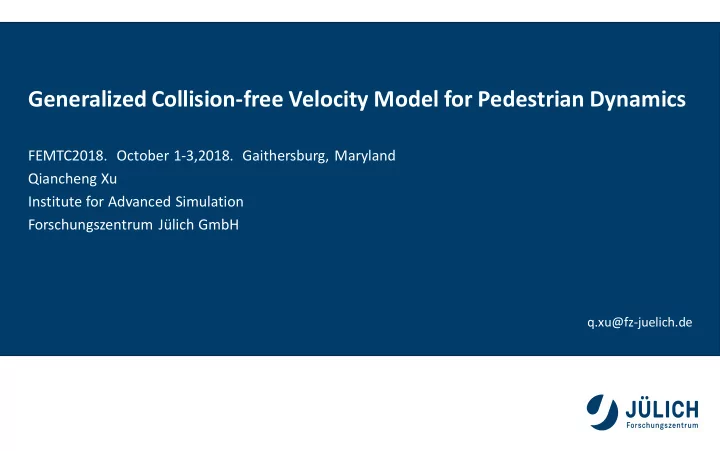

Generalized Collision-free Velocity Model for Pedestrian Dynamics FEMTC2018. October 1-3,2018. Gaithersburg, Maryland Qiancheng Xu Institute for Advanced Simulation Forschungszentrum Jülich GmbH q.xu@fz-juelich.de
Motivation Problems Aim: A new model focus on 1. backward movement 1. merging flow 2. body turning with high 2. collision avoidance frequency 3. eliminating unusual behavior Page 2
Collision-free velocity model Model structure: = V Speed (min spacing ) e ( spacing ) i i i Speed Moving direction Page 3
Extension to the model From circle to dynamical ellipse: • Ellipse can describe the projection of pedestrian in 2D plane better. • Calculation between ellipses is more complex. • The distance between ellipse is estimated. Page 4
Comparison between circle and ellipse • Width: 1.0 ~ 2.5 m Page 5
Comparison between circle and ellipse • Length: 26 m • Width: 1.8 m • N ped : 15 ~ 175 Page 6
Comparison between circle and ellipse Circle: Ellipse: Page 7
New direction model 1. New way to calculate moving direction ( to eliminate backward movement ) Influence of neighbors on pedestrian i: • Always perpendicular to desired moving direction of pedestrian i • Towards the left side of e 0 when neighbors are on the right side or front of e 0 • Towards the right side of e 0 when neighbors are on the left side of e 0 Page 8
New direction model 2. Dynamical vision area ( to reduce probability of blocking) Area i : • Based on moving direction and desired direction of pedestrian i. • Pedestrians in Area i don't influence the moving direction of pedestrian i. Page 9
New direction model Original model: New model: Page 10
New direction model Backward moving index: Shaking index: Page 11
Summary Conclusion: 1. Difference between the performance of circle and ellipse is not very obvious in velocity model. The reason may be the approximation in the distance calculation between ellipses. 2. New direction sub-model can eliminate unusual behavior of agents in simulations. Outlook: Clogging occurs in front of the bottleneck sometimes when the width of bottleneck is very small. Page 12
Page 13
Recommend
More recommend